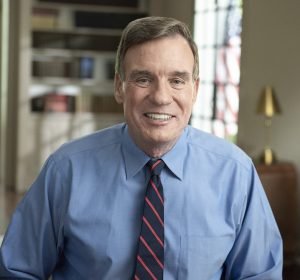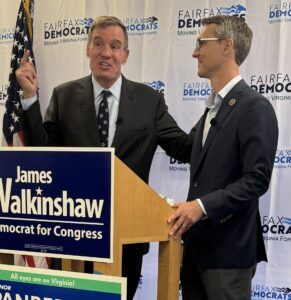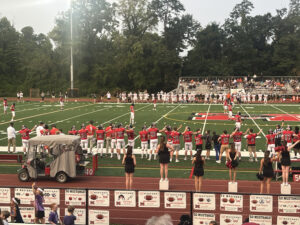Two Sundays ago, the City of Falls Church honored teacher, principal and community activist Mary Ellen Henderson with the dedication of a new middle school named for her. In speeches by local, state and federal officials, Henderson was celebrated for her work bringing awareness to the condition of segregated black schools in Falls Church and Fairfax County.
But though she taught for decades and managed to instigate the building of a new school for black students in Falls Church, by the time she retired, the greatest inequality still existed. Segregation still reigned in Virginia , and blacks were still forced to attend different schools from white students. It wasn’t until the Supreme Court in the mid-1950s stepped in that localities were forced to take action to integrate, and in Virginia in some cases, that took over a decade.
The 1950s struggle to develop and integrate a new school system in the newly-independent City of Falls Church was an heroic and monumental undertaking in its own right, a struggle from which emerged yet another unsung champion, school board chairman John Alvin Johnson.
While Mr. Johnson’s seminal role will be detailed below, we begin this story with an overview of how the newly-established jurisdiction with its own, brand new school system and tasked with winning public support for building its schools and hiring a quality staff while working out its own identity apart from Fairfax County, dealt with segregation in its classrooms. It’s a story about striving to develop a City atmosphere that included a changing paradigm of the traditional educational system in the context of a Southern culture, centuries old.
This article tracks from the moment the Supreme Court made “Brown Vs. Board of Education” ruling on segregation in 1954, the tense discussion going on in the City of Falls Church about whether to integrate. And explains why it wasn’t until six years after the Supreme Court’s second Brown Vs. Board of Education ruling in 1955 that Falls Church became only the second school district in Virginia to admit black students into its classroom.
Most people think the integration of Southern schools began on May 17, 1954 , the day that the Supreme Court decided in the case of Brown vs. Board of Education that the “separate but equal” clause long applied to segregated schools was unconstitutional.
But, actually, it wasn’t until May 31, 1955 that, in a second ruling, the Supreme Court made the decision on the pace at which school systems had to desegregate. In three famous words, “all deliberate speed,” the Supreme Court set in motion a process that would take years, as school systems throughout the South wrestled with and resisted the integration of black students into previously all-white schools.
In some school districts like Prince Edward County in central Virginia, the resistance was so great that the school system ultimately closed the doors of the public schools for five years rather than allow black students to share a classroom with white students. In other localities the resistance wasn’t so great. But as the responsibility of integration shifted back and forth between state and local governments, each jurisdiction was forced to deal with the issue of ending a system of racial separation as old as the colonization of the New World .
A City Divided
In discussing the path towards desegregation, it is first necessary to understand the overall political climate of a City that was just starting out.
It was only six years before the Supreme Court decision on segregation that Falls Church became an independent city, separating itself from Fairfax County on August 15, 1948. Though several reasons were cited at the time including taxes and roads, still active City resident Jessie Thackrey, whose husband Franklin Thackrey helped compose the new city charter, explained in an interview with the News-Press recently that the primary reason for the separation was the desire to have control over an independent school system. It was the feeling of many in Falls Church at the time that under Fairfax County governance, Falls Church schools were under-funded.
But the central role the schools played in the creation of the new jurisdiction also put them at the heart of the debate about the direction of the City. On one side was a new wave of young parents, the “young Turks,” as one of their still thriving number, Lou Olom described them in his recent News-Press interview. Many of these “young Turks” had recently moved to the area, bringing with them advanced degrees, government jobs and quite often, liberal politics.
On the other side were the long-time residents of the small Virginia village, many of whom had family that lived in the area for generations and whose cultural views were much more in tune with the traditional Southern lifestyles that included an ingrained belief in segregation.
So, like the other school systems in Virginia and throughout the rest of the South, the new Falls Church school system began segregated. White students attended schools in the City but since there weren’t any black schools in the small City, all the black students in Falls Church had to attend schools in Fairfax County. Falls Church paid tuition to the county for these students, who totaled only 30 in 1955.
The reason for the small number of African American students in Falls Church was largely due to a decision made in 1887 when Falls Church was just a town. The town leadership voted to cut their town’s size in half, annexing to Fairfax County the area south of Lee Highway known as the “colored settlement.” The decision meant that the City of Falls Church would remain mostly Caucasian, even to this day.
But in the early 1950’s the focus of the community was much more about the overall philosophy of education and the amount of funding going to the schools, than about the status of its black students. While the City had been founded as an independent jurisdiction in 1948 by those who seeking more school funding, by the beginning of the 1950’s there was already a reaction from residents who thought that too many of the City’s resources were going to the schools.
One year after becoming an independent city, in 1949 the City Council passed a $700,000 school bond issue for the building of two new schools. Then, as the 1951 election rolled around, the Council placed a referendum on the ballot requesting another $500,000 bond, half of which would go towards the schools.
Despite the need for new facilities and salaries, there were those in the City who were nervous about that amount of money going to the schools. The request for more money accompanied by attacks from the opposition, galvanized the conservative members of the City, made up largely of small business owners and long term residents. So, in the June 1951 election, the Council that had led the establishment of the independent City just three years prior was voted out of office.
Four months later, six of the seven members of the School Board, which had been appointed by the council, resigned en masse after suffering accusations of mismanagement by a community group calling itself the Falls Church Emergency Schools Committee. The accusations had been made prior to the election, but with the new Council in place the charges were now backed up at City Hall. The board was then replaced with six new members hand-picked by the new Council.
Only one member remained from that original board, our aforementioned Mr. John Alvin Johnson. Mr. Johnson had been overseas during the controversy, doing work for the Air Force. Following the mass resignation of the six School Board members, he was asked whether he would resign as well. He refused, choosing instead to remain on the board, a decision that would prove to be important in the tumultuous years ahead.
“We were lucky to have him there,” Mrs. Thackrey said in her interview with the News-Press. She told of how over the next six years as chairman for the School Board, Johnson fought tooth and nail for continued funding of the schools, despite resistance from a school board largely in favor of cutting the school budget.
But Johnson’s fight on the school board went beyond budgets and school funding when, in 1955, the Supreme Court decision brought desegregation to the forefront. From the time of the Supreme Court decision, he stood alone as the only board member to stand openly for the immediate integration of the Falls Church schools.
A Man and His Cause
By 1951, in the brief time since he came to Falls Church, Johnson had gained a reputation as a brilliant mind and skilled leader. Though he would end up living in Falls Church only eight years, those he worked with remember him to this day with great respect and admiration.
Of Norwegian descent, John Johnson was born in Milwaukee, Wisconsin and spent most of his youth in Hammond, Indiana, a suburb of Chicago. In 1937 he received his bachelor’s degree from DePauw University and a year later, while earning his law degree from the University of Chicago, met Harriet, the woman he would be married to for 67 years until his death just this summer.
During World War II, Johnson served as a naval officer on the destroyer USS Robert H. Smith, which took part in the invasion of Iwo Jima in the Pacific campaign.
After returning from the war, Johnson went back to school to get his master’s degree in law from Harvard University.
In 1949, while working for the State Department, Johnson and his wife moved to Falls Church, just as it was becoming an independent jurisdiction. Immediately Johnson became a charter member of the newly forming city.
In 1952, as he was working on the Falls Church School Board, Johnson was general counsel for the Air Force, a job he held until 1958, when he moved to Arlington and became general counsel for NASA.
He would later go on to an impressive career in the field of satellite communications, serving as international vice president for the Communications Satellite Corporation (Comsat) then as president of Comsat General Corporation.
Described as a deeply religious man, Johnson was a member of the Church of Christ , located in the Culmore area in Falls Church , for over 50 years, serving as a deacon and elder, and helping promote mission work throughout South and Central America , often spending a significant amount of time traveling to those countries bringing aid.
With a history of working towards human rights it is no surprise that during the 1950’s he would champion the issue of integration.
From the time he and his wife moved into Falls Church, Johnson was intent on doing something about segregation. His daughter Barbara Groff, who now lives in Reedville , Virginia with her husband, said that at a very early age she was aware of her father’s concern. She remembers vividly her father’s insistence on fair treatment regardless of race or nationality, and also how disturbed he was by living in an area where bigotry was so accepted.
“He was quite discouraged about it,” Groff said.
The Beginning of a Fight
With the second Supreme Court Brown Vs. Board of Education ruling in 1955, Johnson, who had been meeting regularly with leaders of the African American community (including E.B. Henderson, husband of Mary Ellen Henderson), thought he saw an opening, since the ruling called for integration with “all deliberate speed.” On June 2, just three days after the Supreme Court’s decision, Johnson, as chairman of the School Board, submitted to the board a letter that he’d written and wanted to send to the state Board of Education concerning the integration of the Falls Church schools.
In the letter, Johnson noted the small number of African American students in the Falls Church school district and that there would be little burden placed on the school system from integrating those students into the Falls Church schools.
He wrote: “The Falls Church School Board sees no administrative obstacles to the admission of Negro pupils to the Falls Church public schools. Their number is so small that no increase in either physical facilities or teaching staff would be required for the coming school year if all of them were to be admitted to the Falls Church schools at the opening of school in September 1955.”
But despite his arguments for immediate desegregation, the letter was never sent to the state board. The Falls Church School Board voted to delay a decision on the letter and instead voted to send a letter to the state board requesting that they advise them on how to proceed.
The advice from the state came as no surprise, and was consistent with actions being taken throughout the South. Just a year before after the first Brown Vs. Board decision, Virginia ‘s attorney general had ruled to proceed as always with segregated schools. The advice was, therefore, in keeping with that. The state board instructed school systems to remain segregated while the state worked on the problem.
In August 1955, the Gray Commission was established by Governor Thomas Bahnson Stanley in response to U.S. Senator Harry F. Byrd’s call for “massive resistance” to “radical desegregation.”
Chaired by State Senator Garland Gray the commission came up with a strategy to defy the court decision. The strategy included three recommendations:
- That laws concerning school attendance be amended so that no child would be required to attend an integrated school,
- That funds be allocated as tuition grants for parents who opposed schools comprised of white and black students, and
- That local school boards be authorized to assign white and African American students to particular schools.
While the strategy of the Gray Commission was supposed to make integration more difficult by leaving the action up to the local boards, Johnson saw in the final recommendation another opportunity to push for integration at the local level.
On November 15, 1955 after reviewing the Gray Commission’s statement, Johnson made a proposal to the Falls Church School Board stating, “That the School Board in Falls Church announce as its policy for 1956-57 to permit all negro children living within the city limits of Falls Church to attend the Falls Church public schools according to our present school districting…”
Johnson also stated his opposition to the recommendation by the commission that school systems pay for white students to attend private schools, as he said with less than 10% of the City’s students comprised of African Americans, it would be economically disastrous for areas like Falls Church to support private institutions for white students.
Once again Johnson’s recommendation had trouble finding support. In a surprisingly candid description in the official minutes of the meeting, the different arguments for and against Johnson’s proposal were laid out.
Directly opposing Johnson’s plan was Richard Saintsing, who stated that no action be taken on the Supreme Court’s decision until after a so-called Limited Constitutional Convention proposed by Governor Stanley.
In guarded support of integration was John W. Wells. He proposed that the schools integrate gradually starting with the first grade.
A third position was taken by Jane Dexter, who said that integration was the responsibility of the school board, but that it “should build a climate of feeling in the local community before announcing any policy in this matter.”
The meeting ended with no decision being made.
That would prove to be the last time for a while that the issue of desegregation would be recorded as publicly discussed in Falls Church. Within a couple months, the state took complete control of the integration process, threatening any localities that chose to integrate on their own with a complete loss of state funding. With an amendment to the state constitution, Virginia officially staked its resistance to integration.
To further prevent localities from the integrating, Virginia created the State Pupil Placement Board, a body that for the next four years would decide the placement of students throughout Virginia. With this decision, Falls Church had lost all hope of deciding its own fate.
In 1958, with a new job as general counsel for NASA, Johnson and his family moved out of Falls Church to Arlington. Though he had managed to keep the Falls Church school system well funded, he hadn’t been able to change its practice of segregation.
“It was really an idea whose time had not quite come to Falls Church,” his daughter said recently, talking with the News-Press.
It wouldn’t be until four years later when Falls Church would once again be able to take on the challenge of integrating its schools.
(Part Two next week).













